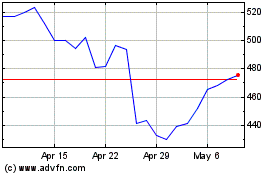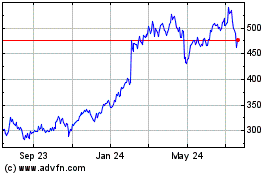Facebook's WhatsApp Gets Green Light to Expand Mobile Payments in India
November 06 2020 - 3:38AM
Dow Jones News
By Newley Purnell
Regulators in India granted Facebook Inc.'s WhatsApp permission
to expand its digital payments service, a win for the company after
a delay of nearly three years in its largest market by users.
The National Payments Corporation of India, or NPCI, said late
Thursday that WhatsApp can bring the service to a maximum of 20
million users. That is up from the one million cap that has been in
place since the encrypted messaging platform in February 2018 began
offering payments via its app in a trial service, the first of its
kind.
"I'm excited to share today that WhatsApp has been approved to
launch payments across India," Facebook Chief Executive Mark
Zuckerberg said in a video provided Friday by the company. The
service, which is free, enables users to connect their bank
accounts to the app and easily send money to one another, just as
if they were sending a typical chat.
Still, WhatsApp remains far from making the functionality
available to all of its more than 400 million users in India. The
NPCI said WhatsApp can start with a maximum of 20 million
users--which would be about 5% of WhatsApp's total user base in the
country.
A spokeswoman for the NPCI didn't immediately respond to a query
about why WhatsApp has been given permission to expand its service.
A WhatsApp spokeswoman declined to comment.
WhatsApp faces stiff competition for payments in the world's
biggest untapped internet economy, where a boom in cheap mobile
data is enabling consumers to make real-time transactions through
inexpensive smartphones. Alphabet Inc.'s Google Pay, Walmart Inc.'s
PhonePe and Paytm, a homegrown champion, have popular payment
services that have been drawing millions of users for years.
A Google spokesman said that as of September 2019 Google Pay had
67 million monthly active users, while PhonePe had 100 million
monthly active users as of last month, a spokeswoman said. A Paytm
spokeswoman said the company has 150 million monthly active users
of its various transaction-related services.
Credit Suisse said in a 2018 research note that digital payments
in India should rise nearly five times to $1 trillion by 2023.
A catalyst for mobile-payment growth in India came in 2016, when
India's government unexpectedly nullified the largest-denomination
cash notes in circulation to curb corruption. That triggered a
crunch, and consumers had to stand in long lines for ATMs. Many
turned to digital payments.
Facebook is locked out of China, the only other country with
more than one billion people, making India a vital market. The
Menlo Park, Calif., company said in April that it was spending $5.7
billion, its largest foreign investment, on a new partnership with
an Indian telecom operator to expand operations in the nation. The
operator's parent company is owned by billionaire Mukesh Ambani,
India's richest man.
India could also be key for Facebook as it seeks to wring
revenue out of WhatsApp, which it paid $22 billion to acquire in
2014. Last month Facebook said it would offer merchants hosting
services, aiming to build upon fees it charges businesses for
certain interactions with customers.
But India has also presented Facebook with challenges. Its
proposal to provide a free, Facebook-centric mobile service was
blocked in 2016 on the grounds that it violated the concept of net
neutrality.
And last month a high-profile Facebook executive who was at the
center of a political storm over the company's handling of
anti-Muslim hate speech left her position.
The Wall Street Journal reported in August that the executive,
Ankhi Das, had opposed applying Facebook's hate-speech rules to a
politician from the ruling Hindu nationalist party, along with at
least three other Hindu nationalist individuals and groups flagged
internally for promoting or participating in violence, according to
current and former employees.
Write to Newley Purnell at newley.purnell@wsj.com
(END) Dow Jones Newswires
November 06, 2020 03:23 ET (08:23 GMT)
Copyright (c) 2020 Dow Jones & Company, Inc.
Meta Platforms (NASDAQ:META)
Historical Stock Chart
From Mar 2024 to Apr 2024

Meta Platforms (NASDAQ:META)
Historical Stock Chart
From Apr 2023 to Apr 2024
